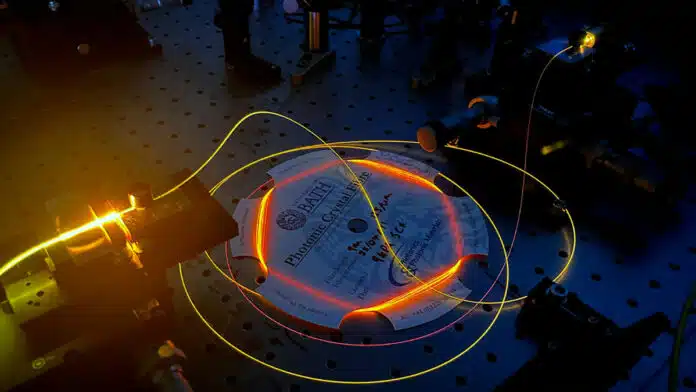
By Amit Malewar 29 Jul, 2024
Collected at: https://www.techexplorist.com/new-gen-optical-fibres-age-quantum-computing/86606/
Physicists at the University of Bath have developed a new generation of specialty optical fibers to address the upcoming challenges in data transfer as we enter the era of quantum computing.
Quantum technologies offer unprecedented computational power, opening doors to solving complex problems, advancing medical research, and enabling secure communication with unbreakable cryptographic techniques. However, current cable networks may not be optimal for quantum communications due to the solid cores of their optical fibers.
Unlike traditional optical fibers, the specialty fibers created at Bath have a micro-structured core with a complex pattern of air pockets running along the entire length of the fiber.
“The conventional optical fibers that are the workhorse of our telecommunications networks of today transmit light at wavelengths that are entirely governed by the losses of silica glass. However, these wavelengths are not compatible with the operational wavelengths of the single-photon sources, qubits, and active optical components that are required for light-based quantum technologies,” said Dr Kristina Rusimova from the Department of Physics at Bath.
Dr Rusimova, who is lead senior author of the paper – known as a perspective – added: “Optical-fibre design and fabrication is at the forefront of the University of Bath Department of Physics research, and the optical fibres we are developing with quantum computers in mind are laying the foundations for the data transmission needs of tomorrow”.
Light is a highly promising medium for quantum computation due to the unique quantum properties of individual light particles or photons. Quantum entanglement is a prime example of this, where separated photons can instantly influence each other’s properties, allowing for significantly more computational power than classical computers. Unlike binary bits, entangled photons can exist simultaneously as both one and zero, offering great potential for quantum technologies.
“A quantum internet is an essential ingredient in delivering on the vast promises of such emerging quantum technology,” said Dr Cameron McGarry, who was a physicist at Bath and the first author of the paper. “Much like the existing internet, a quantum internet will rely on optical fibers to deliver information from node to node. These optical fibers are likely to be very different to those that are used currently and will require different supporting technology to be useful.”
The researchers provide valuable insights into the challenges of the quantum internet in relation to optical fiber technology. They also present a range of potential solutions for building a scalable and robust quantum network. This includes the use of fibers for long-range communication and specialized fibers for quantum repeaters, which can extend the operating distance of this technology.
Furthermore, they explain how these specialty optical fibers can facilitate quantum computation at network nodes by serving as sources of entangled single photons, quantum wavelength converters, low-loss switches, and vessels for quantum memories.
“Unlike the optical fibres that are standardly used for telecommunications, speciality fibres which are routinely fabricated at Bath have a micro-structured core, consisting of a complex pattern of air pockets running along the entire length of the fibre,” Dr McGarry said. “The pattern of these air pockets is what allows researchers to manipulate the properties of the light inside the fiber and create entangled pairs of photons, change the color of photons, or even trap individual atoms inside the fibers.”
“Researchers around the world are making rapid and exciting advancements in the capabilities of microstructured optical fibres in ways that are of interest to industry,” said Dr Kerrianne Harrington who is a postdoctoral researcher in the Department of Physics. “Our perspective describes the exciting advances of these novel fibers and how they could be beneficial to future quantum technologies.”
“It’s the ability of fibres to tightly confine light and transport it over long distances that makes them useful,” added Dr Alex Davis, an EPSRC Quantum Career Acceleration Fellow at Bath. “As well as generating entangled photons, this allows us to generate more exotic quantum states of light with applications in quantum computing, precision sensing and impregnable message encryption.”
Quantum advantage, the capability of a quantum device to outperform a conventional computer, has not been definitively proven yet. The challenges highlighted in the perspective are expected to drive new directions in quantum research, bringing us one step closer to reaching this significant milestone. The optical fibers developed at Bath are anticipated to play a crucial role in establishing the groundwork for the future of quantum computing.
Journal reference:
- Cameron McGarry, Kerrianne Harrington, Alex O. C. Davis, Peter J. Mosley, Kristina R. Rusimova. Microstructured optical fibers for quantum applications: Perspective. Applied Physics Letters Quantum, 2024; DOI: 10.1063/5.0211055

Leave a Reply